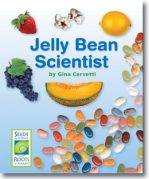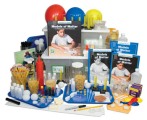When I grow up, I want to be a Jelly Belly scientist!
May 14, 2012 at 4:33 pm Leave a comment
Being a scientist is cool. Being a JELLY BEAN scientist is super cool! Ambrose Lee can attest to this. Ambrose is a food scientist who brainstorms flavor recipes for gourmet jelly beans at Jelly Belly Candy Co. His job is so cool it has been featured in Popular Science magazine. Check out the Jelly Belly web site to learn more about the variety of flavors including crazy ones like:
- Pencil Shavings
- Toothpaste
- Moldy Cheese
- Skunk Spray
Yuck!
The developers of the Seeds of Science/Roots of Reading program were thrilled when Ambrose agreed to be featured in a student book called Jelly Bean Scientist. In the book, readers meet Ambrose and his team of scientists who conduct tests with lab equipment and their own taste buds so the jelly bean flavors they design taste as realistic as possible. Through reading about Ambrose and his work, students learn how scientists design mixtures that have the desired properties, and find out the effects various ingredients have in creating the texture and taste of jelly beans. Readers learn that properties of mixtures include how materials smell, look, taste, and feel. At the end of the book, readers learn background information on the history of jelly beans and get a glimpse into both the hard work and the serendipity of invention.
There is no doubt that this book appeals to children and adults alike. Even if you don’t like jelly beans, you can appreciate the unique career Ambrose enjoys so much. Teachers especially appreciate books like this because of the engagement level it offers students. Teachers also appreciate the associated strategy guide that details ways to teach about text structure using this book. The strategy guide, Teaching Text Structure (click for free pdf download), introduces an approach for teaching students how to identify any book’s text structure. Text structure refers to how a text is organized; understanding this organization can support reading comprehension. Science texts are often organized around conventional structures such as cause–effect or compare–contrast. The guide includes an introductory section about the strategy of identifying a text’s structure and a description of how to teach this strategy with many science texts, including Jelly Bean Scientist. Teaching text structure can be a valuable part of literacy lesson plans.
Do you want to be notified when we publish new blog articles? Simply enter your email address in the “Follow Blog via Email” box located in the right sidebar.
Entry filed under: Informational text, Strategy Guide. Tags: 3rd grade science, books, Designing Mixtures, elementary curriculum, elementary lesson plans, elementary school science, elementary science, Jelly Bean Scientist, physical science, science classroom, science resources, science teachers, second grade science, strategy guides.




Trackback this post | Subscribe to the comments via RSS Feed